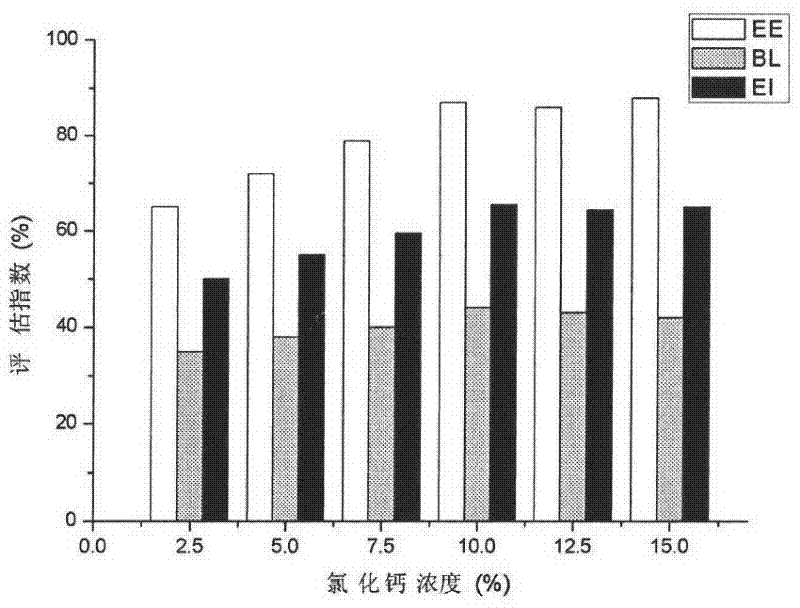Preparation method and application of microecological bactericide for sustained release in water
A slow-release bacterial agent and micro-ecological technology, which is applied in the field of biotechnology and micro-ecological preparations, can solve the problems of short service life, affecting the survival of aquatic animals, and low feeding concentration.
- Summary
- Abstract
- Description
- Claims
- Application Information
AI Technical Summary
Problems solved by technology
Method used
Image
Examples
Embodiment 1
[0029] Embodiment 1: Enrichment culture of Bacillus subtilis spores
[0030] The Bacillus subtilis used in the present invention is preserved in the General Microorganism Center of China Microbiological Culture Collection Management Committee, with the preservation number CGMCC No.3871, and the preservation date is May 24, 2010. The bacterium was transferred from the preserved slant to a fresh slant, and incubated at 37°C for 48 hours. Inoculate a loop to 50ml of seed medium from the slant, and culture on a shaker at 37°C and 200rpm for 16h. 3L of fermentation medium was loaded into a 5L fermenter, and 5% of the inoculation amount was added to the seed liquid, and cultured at 37° C. for 48 hours at 500 rpm to obtain a spore fermentation liquid. The spores were collected by centrifuging the fermentation liquid at 10000 rpm for 5 minutes, and air-dried at 80° C. for 4 hours to obtain spore powder as the microcapsule core material.
Embodiment 2
[0031] Embodiment 2: the preparation of Bacillus subtilis microcapsules
[0032] Using gelatin and sodium alginate as mixed wall materials, Bacillus subtilis spore dry powder as core material, and calcium chloride as solidification solution, microcapsules were prepared by sharp hole solidification method. The effect of each component on the physical properties of microcapsules was studied.
[0033] 1. The effect of sodium alginate mass concentration on the preparation of microcapsules
[0034] Keep the gelatin concentration at 0.6%, CaCl 2 The concentration is 10%, the concentration of spores in the core material is 2%, and the microcapsules are prepared with different concentrations of sodium alginate. The results are as follows: figure 1 : When the concentration of sodium alginate is less than 1.5%, the bacteria loading and embedding rate of the microcapsules are directly proportional to the concentration of sodium alginate, and then inversely proportional. This may be be...
Embodiment 3
[0047] Embodiment 3: the application effect of bacillus subtilis microcapsule preparation
[0048] in 1M 2 In the river prawn cultivation test pond of the present invention, the application effect of the product of the present invention in aquaculture has been studied. The experiment set up the control group (no addition) and the test group (adding 50g of microcapsule bacterial agent), inoculated 2.0-2.5cm juvenile shrimp, and fed the same artificial feed every day. The research results are as follows: the pH value of the water body in the test group was maintained at 7.0-7.5 Among them, the ammonia nitrogen content was lower than 0.4mg / L, and the dissolved oxygen was higher than 3.0mg / L, which was in a dynamic equilibrium process with the number of Bacillus subtilis flora, and the survival rate of river shrimp was above 99% in 60 days; while the water pH of the blank group It reached 6.2 in 29 days, and then the river prawns grew slowly, the ammonia nitrogen content in the w...
PUM
 Login to View More
Login to View More Abstract
Description
Claims
Application Information
 Login to View More
Login to View More - R&D
- Intellectual Property
- Life Sciences
- Materials
- Tech Scout
- Unparalleled Data Quality
- Higher Quality Content
- 60% Fewer Hallucinations
Browse by: Latest US Patents, China's latest patents, Technical Efficacy Thesaurus, Application Domain, Technology Topic, Popular Technical Reports.
© 2025 PatSnap. All rights reserved.Legal|Privacy policy|Modern Slavery Act Transparency Statement|Sitemap|About US| Contact US: help@patsnap.com



